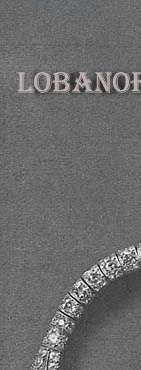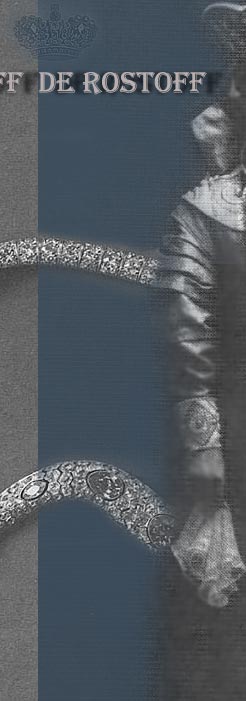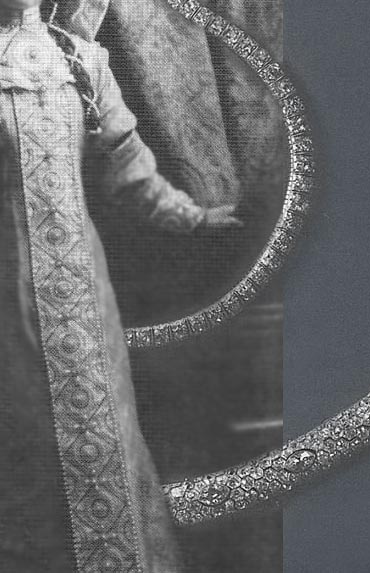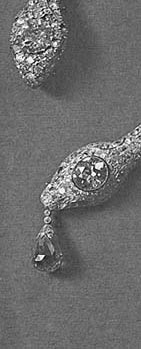Aus dem Versteigerungs-Katalog von 1920 in Lausanne, Juwelen und
Schmuck aus der unglaublichen Sammlung von der in Vevey verstorbenen
Prinzessin Vera Lobanov
Die großartige Schmucksammlung der Prinzessin Vera Lobanoff
von Rostoff, von Fachleuten wie von Edelstein-Liebhabern gleichermaßen
bewundert, steht zum Verkauf. Diese Kollektion, einzigartig sowohl
in ihrer Auswahl und Vielfalt, als auch durch das Feingefühl
und Wissen, mit der sie zusammengestellt worden ist, verdient besondere
Aufmerksamkeit: sie ist das Lebenswerk dieser Dame mit viel Geschmacl,
die ständig versuchte, ihre Sammlung durch weitere Objekte zu
vervollständigen.
Ihr zweites Bestreben war die Sorge ums Gemeinwohl: ihre Freunde
kannten ihre Wohltätigkeit und Güte, die sie hinter extremer
Bescheidenheit versteckte.
Die Prinzessin Vera Nikolajewna heiratete im Alter von 16 Jahren den
Prinzen Jacques Lobanoff von Rostoff, jüngster Bruder des Prinzen
Alexis Borsovitch Lobanoff von Rostoff, russischer Botschafter am
Hof von Wien, London und der Türkei und danach Außenminister
in Russland.
Während der Herrschaft der Zaren Alexander II, Alexander III
und Nikolaus II. unterzeichneten die Prinzen dieser Familie mit dem
Namen "Lobanoff von Rostoff", und diese Schreibweise, die
in allen internationalen und diplomatischen Urkunden übernommen
wurde, ist ihnen geblieben.
Vera Lobanoff war eine Prinzessin aus dem Herrscherhaus der Rurik,
deren erster Vertreter, ein russischer Großherzog, 862 n. Chr.
erwähnt wird und deren letzter Johannes IV (der Schreckliche)
war, Zar aller Russen.
Die Mutter der Prinzessin stammt aus dem Hause Chatilow, das aus
einer alten Adelsfamilie unter der Regierungszeit Toulas hervorgegangen
ist. Ihre Schönheit war so berühmt, dass man sie "La
violette de St. Pétersbourg" ( Veilchen von St. Petersburg)
nannte. Die Prinzessin von Georgien, eine geborene Dolgorouky, war
die Schwester der Prinzessin Vera Lobanoff.
Sehr jung Witwe und in Besitz eines riesigen Vermögens, ging
die Prinzessin Lobanoff von Rostoff ihren Neigungen nach, deren ausgeprägteste
die Sammlung von Kunstwerken aller Art war.
Ihr wunderschönes Palais in Moskau wurde durch die ungeheure
Weite ihres Parks vor dem Grossbrand von 1812 gerettet. In diesem
Wohnsitz, den sie scherzhaft "ihre kleine Eremitage" nannte,
sammelte sie alles, was sie in der Welt an Schönem und Interessantem
fand: Gemälde ebenso wie Kunstobjekte. Sie besaß bereits
eine bedeutende Galerie von Familienportraits. Ihr Palais galt als
Modell für feinste russische Eleganz und Luxus.
Der russische Großherzog Sergej, der mit der Schwester der
Zarin verheiratet war und später das Opfer des Bombenanschlags
von 1904 wurde, verkehrte häufig im Palais der Prinzessin in
Moskau. Der Tod dieses unglücklichen Großherzogs erschütterte
sie zutiefst, dieses Ereignis erschien ihr symptomatisch, sie sah
darin das Vorzeichen einer schrecklichen Revolution.
Danach verließ sie Russland und zog nach Frankreich, wo sie
schon ihre Jugend verbracht hatte und das sie als zweite Heimat betrachtete.
Neben ihrem Palais in Paris, dem Hôtel du Ranelgah, besaß
sie zwei Landsitze in Menton und Vevey, in denen sie abwechselnd ihre
Zeit verbrachte. In Frankreich traf sie ihre Cousine, Prinzessin Youriewski,
geborene Dolgorouky und Witwe von Zar Alexander II, wieder, mit der
sie eine beständige und enge Freundschaft verband, sowie deren
Schwester, die Gräfin Georges Berg.
In dieser Zeit begann die Leidenschaft der Prinzessin Lobanoff für
Edelsteine, sie kaufte unermüdlich und überall.
Denen, die sich darüber wunderten, entgegnete sie: "Das
sind lohnende Anlagen. Ich verschwende nichts, im Gegenteil, ich baue
ein zweites Vermögen auf."
Der Lauf der Ereignisse seitdem zeigte, wie recht sie damit hatte.
Der Verkauf dieser Schmuckstücke wird im Januar (1920) in Lausanne
stattfinden und wird den Liebhabern beweisen, ob sich ihr ihre Anlagen
auszahlen werden..
Das berühmte Collier aus rosa Perlen, das Zar Nikolaus I einst
seiner Lieblingstochter, der Großherzogin Marie, kaufte wird
in dieser bewundernswerten Sammlung besondere Aufmerksamkeit erregen.
An besonderen Tagen, aber doch sehr selten zeigte sich die Prinzessin
in diesen schönen Schmückstücken ihren engsten Freunden.
Sie hatte ihre eigene Art und Weise, diese beeindruckenden Kunstwerke
zu präsentieren. Und wie sie es schaffte die Aufmerksamkeit auf
die Schönheit der Goldschmiedearbeit zu lenken zeigte, dass ihr
Sinn für das Künstlerische sehr ausgereift war.
In Prinz Alexis Lobanoff von Rostoff schlummerte ebenfalls eine Künstlerseele:
er vereinigte die schönsten Portraits aus der Epoche Katharina
II in seiner Sammlung, die er dem Zarenmuseum von Alexander III vermachte.
Dort nimmt sie einen ganzen Ausstellungssaal in beschlag, der nach
den Prinzen Lobanoff benannt ist.
Jetzt, wo so viele schöne Dinge der Vergangenheit auseinander
gerissen werden, ruft die Erinnerung an die kleine Eremitage Lobanoff
in Moskau tiefste Trauer hervor! Die Prinzessin, die seit dem Krieg
(1. Weltkrieg) ihre Villa in Vevey nicht mehr verlassen hatte, verbrachte
ihre Zeit damit, die Unglücklichen zu unterstützen, die
sich in ihrer Umgebung sammelten. Die Unruhen, die verschiedenen Ängste
und das unheilbare Leid, das ihr der Zusammenbruch ihres Heimatlandes
bereitete, verschlimmerten ihr Herzleiden, dem sie erlag: sie starb
am Schmerz über die Zerschlagung ihrer Heimat.
Ihren letzten Trost erhielt die Prinzessin von der edlen und wohlwollenden
Gastfreundschaft der Schweiz, deren Tore den Unglücklichen immer
geöffnet waren. Die verfolgten und aus ihrem Land vertriebenen,
ruinierten und unglücklichen Russen vergessen nie die barmherzige
und taktvolle Aufnahme, die ihnen auf schweizerischem Boden zuteil
wurde.
Georges Berg
November 1919
Hier im Bild oben, ein Collier in Form einer beweglichen Schlange,
die Schlangen-Elemente sind in Mustern mit Brillanten besetzt und
einem großen Brillant im Kopf gefasst.
Darunter eine weitere Brillant-Schlange mit vierzehn Navette-Diamanten
in fancy coloured Farben (couleur fantaisie)entlang dem schuppenförmigen
Körper verteilt, ebenfalls mit getönten Diamanten ausgefasst.
Ein grosser Brillant ist im Kopf integriert und ein Diamant-Briolette
hängt beweglich am Maul des Reptils, diese phantasiefarbenen
Diamanten werden auch "fancy color diamonds" genannt.
In seinen Memoiren, schreibt Fürst Felix später über diese Juwelen
als ....eines schöner als das andere.....ein Triumph für Chaumet
und seinen bezaubernden und originellen Schöpfungen.
Man kann annehmen, das somit viele Stück von Chaumet aus Paris
stammen, auf ihre kostbare Passion angesprochen, antwortete die Prinzessin,
"das ist eine gute Anlageform, ich verschwende nichts, ich
bilde ein weiteres Vermögen".
Auch im Bild Princessin Maria Alexandrovna Lobanoff-Rostovsky, Demoisell
d`Honneur der russischen Zarin, Tochter von Alexander Borisovitch
Lobanoff-Rostovsky und seiner Frau Prinzessin Cathrine Ilyitchna Dolgoroukoff,
sie heiratete später Wladimir Dimitrieviitch Ourousoff
Vielen Dank an Caroline für ihre promte Hilfe beim Übersetzen
Collier, serpente articulé, pavé brillants, avec un
gros brillant sur la tête.
Collier, serpente brillants, ave quatorze brillants navettes, couleur
fantaisie, intercalés dans les éailles, un brillant
de fantaisie sur la tête, tenant une briolette de fantaisie.
Manifique diadème joaillerie rinceaux, brillants, surmonté d'un gros
brillant. Diadème en brillants, rinceaux feuilles d'acanthe; au centre,
un très beau brillant pesant environ neuf carats, accompagné notamment
de dix autres moins importants Diadème empire, dessin russe, bande
feuilles de laurier, ruban brillants et roses.
Above two necklaces of the princess in form of serpents, made with
a lot of fancy coloured diamonds, brillants, diamond navettes and
diamond-briolette.
Princess Vera Nikolajewna Lobanov Rostovsky (1836-1914). Born Schablickine,
she married the prince Jacques Lobanoff de Rostoff in 1858 at Saint
Petersburg. The prince and princess were among the first of what was
to become the Russian colony in Cannes, living at Villa Tropicale,
Allée des Bleuets, from 1903 to 1914.
Princess was married, at the age of 16, to the younger brother of
prince Alexis Borisovitch Lobanoff de Rostoff, ambassador of Russia
to the courts of Vienna, London and the Sublime Door, and later Russian
foreign minister.
Princess Vera was herself a princess Dolgorouky, from the Rurik dynasty
the first member of which was grand-duke lvan of Russia, who lived
in the 800s, and the last of which was Ivan IV, known as Ivan the
Terrible, Czar of all Russias.
Princess Vera's mother was a Chatilow, belonging to an ancient family
of the nobility of the government of Toula. Known as the "Violet
of Pétersbourg", her beauty was legendary.
Vera Lobanoff de Rostoff, became a widow at a very young age, and
was left with a great fortune. Being a woman of independent means
allowed her to pursue her passion for the arts.
She lived in a beautiful palace in Moscow, surrounded by a vast park.
In this residence, which she liked to call "her small Hermitage",
she accumulated a large collection of beautiful and interesting things
imported from all over the world. She also possessed an important
gallery of family portraits. Her house was a model of Slavic elegance
and refined luxury.
She also developed a passion for the beautiful jewellery; which she
purchased with great enjoyment, everywhere she went. To those who
were astonished by her purchases, she answered: "They are wise
investments; I am not squandering anything; on the contrary, I am
building a second fortune from the first one".
From the auction catalogue of 1920 in Lausanne, jewels and jewellery from the incredible collection of Princess Vera Lobanov, who died in Vevey
The magnificent jewelry collection of Princess Vera Lobanoff of Rostoff, admired by experts and gem lovers alike, is for sale. This collection, unique in its selection and variety, as well as the sensitivity and expertise with which it was assembled, deserves special attention: it is the life's work of this lady of great taste, who continually sought to expand her collection with new pieces.
Her second endeavor was concern for the common good: her friends recognized her charity and kindness, which she concealed behind extreme modesty.
At the age of 16, Princess Vera Nikolaevna married Prince Jacques Lobanoff of Rostoff, youngest brother of Prince Alexis Borsovitch Lobanoff of Rostoff, Russian ambassador to the court of Vienna, London, and Turkey, and later Foreign Minister of Russia.
During the reigns of Tsars Alexander II, Alexander III, and Nicholas II, the princes of this family signed their names with the name "Lobanoff of Rostoff," and this spelling, adopted in all international and diplomatic documents, has stuck with them.
Vera Lobanoff was a princess from the ruling House of Rurik, whose first representative, a Russian Grand Duke, is mentioned in 862 AD, and whose last was John IV (the Terrible), Tsar of all the Russias.
The princess's mother came from the House of Chatilov, which originated from an old aristocratic family during the reign of Toula. Her beauty was so renowned that she was called "La Violette de St. Pétersbourg" (Violet of St. Petersburg). The Princess of Georgia, née Dolgorouky, was the sister of Princess Vera Lobanoff.
A very young widow and in possession of a huge fortune, Princess Lobanoff of Rostoff followed her passions, the most pronounced of which was the collection of works of art of all kinds.
Her beautiful palace in Moscow was saved from the great fire of 1812 by the immense expanse of its park. In this residence, which she jokingly called "her little Hermitage," she collected everything beautiful and interesting she found in the world: paintings as well as art objects. She already owned a significant gallery of family portraits. Her palace was considered a model of the finest Russian elegance and luxury.
The Russian Grand Duke Sergei, who was married to the Tsarina's sister and later fell victim to the bombing of 1904, frequently visited the Princess's palace in Moscow. The death of this unfortunate Grand Duke shocked her deeply; this event seemed symptomatic to her, and she saw it as the harbinger of a terrible revolution.
She then left Russia and moved to France, where she had spent her youth and which she considered her second home.
In addition to her palace in Paris, the Hôtel du Ranelgah, she owned two country estates in Menton and Vevey, where she alternated her time. In France, she reunited with her cousin, Princess Youriewski, née Dolgorouky, widow of Tsar Alexander II, with whom she maintained a close and lasting friendship, as well as her sister, Countess Georges Berg.
It was during this period that Princess Lobanoff's passion for precious stones began; she bought them tirelessly and everywhere.
To those who expressed surprise, she replied: "These are worthwhile investments. I'm not wasting anything; on the contrary, I'm building a second fortune."
The course of events since then has shown how right she was.
The sale of these jewels will take place in Lausanne in January 1920 and will prove to connoisseurs whether her investments will pay off.
The famous necklace of pink pearls, which Tsar Nicholas I once bought for his favorite daughter, Grand Duchess Marie, will attract particular attention in this admirable collection.
On special occasions, but very rarely, the princess would show herself to her closest friends in these beautiful pieces of jewelry. She had her own way of presenting these impressive works of art. And the way she managed to draw attention to the beauty of the goldsmith's work demonstrated that her sense of artistry was very sophisticated.
Prince Alexis Lobanoff of Rostoff also possessed an artistic soul: he assembled the most beautiful portraits from the era of Catherine II in his collection, which he bequeathed to the Tsarist Museum of Alexander III. There, they occupy an entire exhibition hall named after Prince Lobanoff.
Now, when so many beautiful things of the past are being torn apart, the memory of the small Lobanoff Hermitage in Moscow evokes deep sorrow! The princess, who hadn't left her villa in Vevey since the war (World War I), spent her time supporting the unfortunate people who gathered around her. The unrest, the various anxieties, and the incurable suffering caused by the collapse of her homeland aggravated her heart disease, to which she succumbed: she died of the pain of the destruction of her homeland.
The princess received her final consolation from the noble and benevolent hospitality of Switzerland, whose gates were always open to the unfortunate. The persecuted and exiled Russians, ruined and unhappy, never forget the merciful and tactful welcome they received on Swiss soil.
Georges Berg
November 1919
Pictured above, a necklace in the shape of a moving snake. The snake elements are patterned with diamonds, with a large diamond set in the head.
Below, another diamond snake with fourteen navette diamonds in fancy colors (couleur fantaisie) distributed along the scale-like body, also set with tinted diamonds. A large diamond is integrated into the head, and a diamond briolette hangs flexibly from the reptile's mouth. These fancy-colored diamonds are also called "fancy color diamonds."
In his memoirs, Prince Felix later wrote of these jewels as ...each one more beautiful than the other...a triumph for Chaumet and his enchanting and original creations.
One can assume that many pieces come from Chaumet in Paris. When asked about her precious passion, the princess replied, "It's a good investment, I'm not wasting anything, I'm building up another fortune."
Also in the picture Princess Maria Alexandrovna Lobanoff-Rostovsky, Demoisell d`Honneur of the Russian Tsarina, daughter of Alexander Borisovitch Lobanoff-Rostovsky and his wife Princess Cathrine Ilyitchna Dolgoroukoff, she later married Vladimir Dimitrieviitch Ourousoff
Special thanks for translation to Robert!
THE COLLECTION | Princess Lobanoff de Rostoff Important Jewellery:













